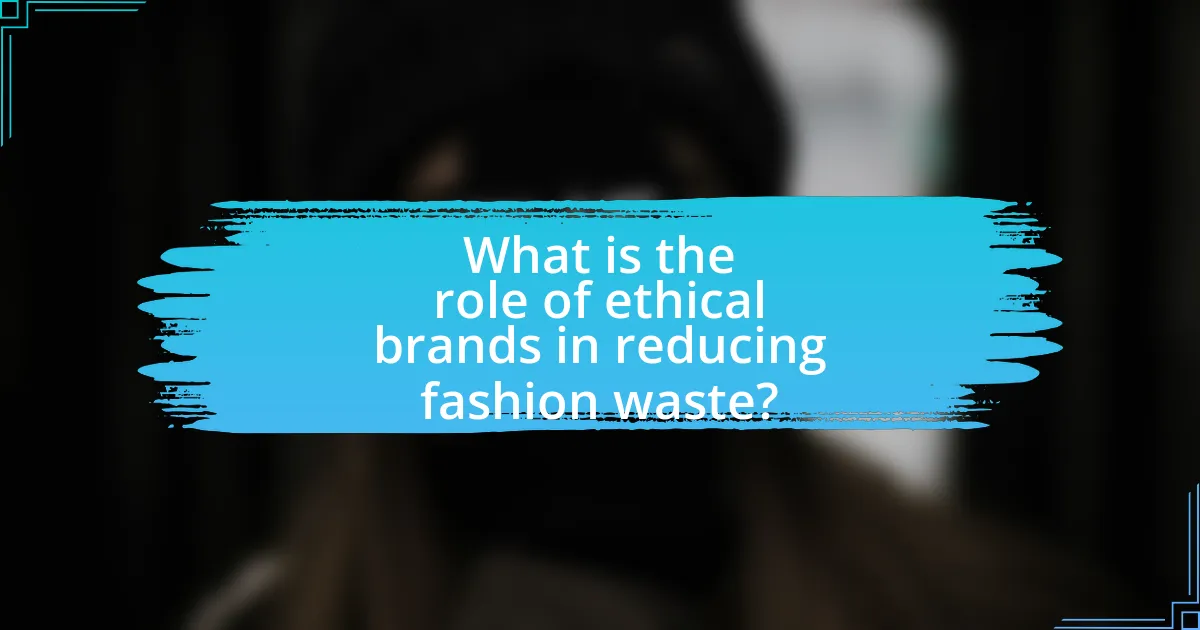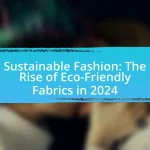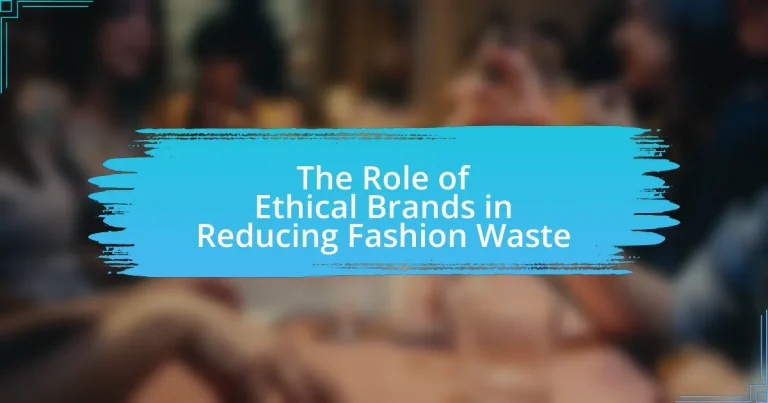Ethical brands play a vital role in reducing fashion waste by promoting sustainable practices, responsible consumption, and transparency in their operations. They utilize eco-friendly materials, implement fair labor practices, and encourage consumers to prioritize quality over quantity. The article explores how these brands contribute to sustainable fashion, the principles guiding their operations, and the impact of consumer behavior on sustainability. It also addresses the environmental and social implications of fashion waste, the challenges ethical brands face, and the innovations emerging to further reduce waste in the industry. Additionally, practical steps for consumers to support ethical brands are outlined, emphasizing the benefits for both individuals and the environment.

What is the role of ethical brands in reducing fashion waste?
Ethical brands play a crucial role in reducing fashion waste by promoting sustainable practices and responsible consumption. These brands often utilize eco-friendly materials, implement fair labor practices, and encourage consumers to buy less and choose quality over quantity. For instance, a study by the Ellen MacArthur Foundation highlights that the fashion industry is responsible for 92 million tons of waste annually, and ethical brands aim to mitigate this by adopting circular economy principles, such as recycling and upcycling. By prioritizing transparency and sustainability, ethical brands not only minimize waste but also influence consumer behavior towards more environmentally conscious choices.
How do ethical brands contribute to sustainable fashion practices?
Ethical brands contribute to sustainable fashion practices by prioritizing environmentally friendly materials, fair labor practices, and transparent supply chains. These brands often utilize organic or recycled materials, which significantly reduce the environmental impact associated with traditional textile production. For instance, a study by the Global Fashion Agenda indicates that using recycled polyester can reduce carbon emissions by up to 32% compared to virgin polyester. Additionally, ethical brands ensure fair wages and safe working conditions for their workers, promoting social sustainability. By adopting transparent supply chains, these brands allow consumers to make informed choices, fostering a culture of accountability and encouraging other companies to adopt similar practices.
What principles guide ethical brands in their operations?
Ethical brands operate under principles such as sustainability, transparency, and social responsibility. Sustainability ensures that brands minimize environmental impact by using eco-friendly materials and practices, which is crucial in reducing fashion waste. Transparency involves clear communication about sourcing, production processes, and labor practices, allowing consumers to make informed choices. Social responsibility emphasizes fair labor practices and community engagement, ensuring that workers are treated ethically and compensated fairly. These principles collectively guide ethical brands in their operations, fostering a more responsible and sustainable fashion industry.
How do ethical brands influence consumer behavior towards sustainability?
Ethical brands significantly influence consumer behavior towards sustainability by promoting transparency and responsible practices, which resonate with environmentally conscious consumers. Research indicates that 66% of global consumers are willing to pay more for sustainable brands, highlighting a shift in purchasing decisions driven by ethical considerations. Furthermore, ethical brands often engage in storytelling that emphasizes their commitment to sustainability, which fosters a deeper emotional connection with consumers and encourages them to support eco-friendly practices. This connection is reinforced by the fact that consumers increasingly seek to align their values with their purchasing choices, leading to a preference for brands that demonstrate social and environmental responsibility.
Why is reducing fashion waste important?
Reducing fashion waste is important because it significantly mitigates environmental damage and conserves resources. The fashion industry is responsible for approximately 10% of global carbon emissions and is a major contributor to water pollution and waste generation. By minimizing waste, brands can lower their carbon footprint, reduce landfill overflow, and decrease the consumption of water and raw materials. For instance, the Ellen MacArthur Foundation reports that if current trends continue, the fashion industry could account for more than a quarter of the global carbon budget by 2030. Therefore, reducing fashion waste is crucial for promoting sustainability and protecting the planet.
What are the environmental impacts of fashion waste?
Fashion waste significantly contributes to environmental degradation, primarily through landfill overflow, pollution, and resource depletion. Approximately 92 million tons of textile waste are generated globally each year, with a substantial portion ending up in landfills, where it can take decades to decompose, releasing harmful greenhouse gases like methane. Additionally, the production of fashion items consumes vast amounts of water and energy; for instance, producing a single cotton t-shirt requires about 2,700 liters of water, exacerbating water scarcity issues. Furthermore, the dyeing and finishing processes of textiles often involve toxic chemicals that can contaminate water sources, harming aquatic ecosystems. These facts illustrate the severe environmental impacts of fashion waste, highlighting the urgent need for sustainable practices in the industry.
How does fashion waste affect social and economic factors?
Fashion waste negatively impacts social and economic factors by contributing to environmental degradation and perpetuating labor exploitation. The fashion industry is responsible for 10% of global carbon emissions and significant water pollution, which affects communities and ecosystems. Economically, the disposal of unsold clothing leads to financial losses for brands and contributes to a cycle of poverty in developing countries where labor is often exploited. For instance, the World Bank estimates that the fashion industry could lose $500 billion annually due to waste and inefficiencies. This waste not only strains resources but also undermines the livelihoods of workers in the supply chain, highlighting the urgent need for ethical brands to adopt sustainable practices that mitigate these adverse effects.

What strategies do ethical brands use to minimize fashion waste?
Ethical brands minimize fashion waste through strategies such as sustainable sourcing, production transparency, and circular fashion initiatives. Sustainable sourcing involves using eco-friendly materials that reduce environmental impact, while production transparency ensures that brands disclose their manufacturing processes, allowing consumers to make informed choices. Circular fashion initiatives, such as take-back programs and recycling, encourage consumers to return used items for repurposing or recycling, thus extending the lifecycle of products. These strategies collectively contribute to reducing the overall waste generated in the fashion industry.
How do ethical brands implement circular fashion models?
Ethical brands implement circular fashion models by designing products for longevity, promoting recycling, and encouraging the return of used items. These brands focus on sustainable materials and production processes, ensuring that their products can be reused or recycled at the end of their life cycle. For instance, companies like Patagonia and Eileen Fisher have established take-back programs that allow customers to return worn items for repair or recycling, thereby reducing waste. According to a report by the Ellen MacArthur Foundation, transitioning to a circular economy in fashion could reduce greenhouse gas emissions by 44% by 2030, highlighting the effectiveness of these models in mitigating environmental impact.
What are the key components of a circular fashion model?
The key components of a circular fashion model include design for longevity, sustainable materials, recycling and upcycling, and a focus on consumer engagement. Design for longevity ensures that products are made to last, reducing the need for frequent replacements. Sustainable materials involve using resources that are renewable and have a lower environmental impact, such as organic cotton or recycled polyester. Recycling and upcycling processes allow for the recovery of materials from used garments, minimizing waste and promoting resource efficiency. Finally, consumer engagement encourages responsible consumption and awareness of the environmental impact of fashion choices, fostering a culture of sustainability. These components collectively contribute to reducing fashion waste and promoting a more sustainable industry.
How do these models reduce waste in the fashion industry?
These models reduce waste in the fashion industry by implementing sustainable practices such as circular production, which emphasizes recycling and reusing materials. For instance, brands like Patagonia and Eileen Fisher utilize take-back programs that encourage customers to return used garments, allowing the materials to be repurposed into new products. According to a report by the Ellen MacArthur Foundation, transitioning to a circular economy in fashion could reduce waste by up to 80% by 2030. Additionally, these models often prioritize limited production runs and on-demand manufacturing, which minimizes overproduction and excess inventory, further contributing to waste reduction.
What role does transparency play in ethical branding?
Transparency is crucial in ethical branding as it fosters trust and accountability between brands and consumers. When brands openly share information about their sourcing, production processes, and labor practices, they enable consumers to make informed choices aligned with their values. Research indicates that 94% of consumers are likely to be loyal to a brand that offers complete transparency, highlighting its importance in building long-term relationships. Furthermore, transparency can lead to improved brand reputation and customer loyalty, as consumers increasingly demand ethical practices in response to environmental concerns, particularly in the fashion industry, where waste reduction is a significant issue.
How do ethical brands communicate their sustainability efforts?
Ethical brands communicate their sustainability efforts through transparent messaging, engaging storytelling, and verified certifications. These brands often utilize social media platforms and their websites to share detailed information about their sustainable practices, such as sourcing materials responsibly, reducing carbon footprints, and implementing fair labor practices. For instance, brands like Patagonia and Eileen Fisher frequently publish sustainability reports that outline their environmental impact and goals, reinforcing their commitment to ethical practices. Additionally, certifications from organizations like Fair Trade and Global Organic Textile Standard serve as proof of their claims, enhancing consumer trust and credibility.
What impact does transparency have on consumer trust?
Transparency significantly enhances consumer trust by fostering a sense of honesty and accountability in brands. When consumers are informed about a brand’s practices, sourcing, and production processes, they are more likely to feel secure in their purchasing decisions. Research from the 2021 Edelman Trust Barometer indicates that 81% of consumers need to trust a brand to buy from them, highlighting the critical role transparency plays in building that trust. Furthermore, brands that openly share their sustainability efforts and ethical practices can differentiate themselves in a crowded market, leading to increased loyalty and repeat purchases.

What challenges do ethical brands face in reducing fashion waste?
Ethical brands face significant challenges in reducing fashion waste, primarily due to higher production costs and consumer demand for fast fashion. These brands often utilize sustainable materials and ethical labor practices, which can increase costs by 20-30% compared to conventional methods. Additionally, the fast-paced nature of consumer trends leads to a preference for cheaper, quickly produced items, making it difficult for ethical brands to compete. According to a 2021 report by McKinsey & Company, the global fashion industry generates over 92 million tons of waste annually, highlighting the systemic issues that ethical brands must navigate to promote sustainability effectively.
How do market pressures affect ethical brands’ sustainability efforts?
Market pressures significantly influence ethical brands’ sustainability efforts by compelling them to balance profit margins with environmental and social responsibilities. As consumer demand for sustainable products rises, ethical brands often face the challenge of maintaining competitive pricing while adhering to sustainable practices. For instance, a study by Nielsen found that 66% of global consumers are willing to pay more for sustainable brands, which incentivizes ethical brands to invest in sustainable materials and practices. However, intense competition can lead some brands to compromise on their sustainability commitments to reduce costs, ultimately undermining their ethical positioning.
What are the common misconceptions about ethical fashion?
Common misconceptions about ethical fashion include the belief that it is prohibitively expensive, that it lacks style, and that it is only a trend rather than a sustainable movement. Many consumers assume that ethical clothing is significantly more expensive than fast fashion, but studies show that while some ethical brands may have higher price points, they often reflect fair labor practices and sustainable materials, which can lead to long-term savings through durability. Additionally, the notion that ethical fashion is unstylish is inaccurate; many ethical brands prioritize design and aesthetics, proving that sustainability and style can coexist. Lastly, the idea that ethical fashion is merely a passing trend overlooks the growing consumer demand for sustainable practices, as evidenced by a 2021 McKinsey report indicating that 67% of consumers consider sustainability when making a purchase.
How do ethical brands navigate competition with fast fashion?
Ethical brands navigate competition with fast fashion by emphasizing sustainability, transparency, and quality over quantity. These brands often utilize eco-friendly materials and ethical labor practices, which appeal to a growing consumer base that values responsible consumption. For instance, a report by McKinsey & Company indicates that 66% of global consumers are willing to pay more for sustainable brands, demonstrating a market shift towards ethical purchasing. Additionally, ethical brands leverage storytelling and brand authenticity to connect with consumers, differentiating themselves from fast fashion’s often impersonal approach. This strategy not only fosters customer loyalty but also positions ethical brands as leaders in the movement towards reducing fashion waste.
What are the future trends for ethical brands in the fashion industry?
Future trends for ethical brands in the fashion industry include increased transparency in supply chains, a focus on sustainable materials, and the rise of circular fashion models. Ethical brands are expected to adopt technologies that enhance traceability, allowing consumers to verify the origins and sustainability of products. According to a report by McKinsey & Company, 67% of consumers consider sustainability when making a purchase, indicating a growing demand for eco-friendly practices. Additionally, the shift towards circular fashion, which emphasizes recycling and upcycling, is projected to gain momentum as brands seek to minimize waste and extend the lifecycle of garments.
How is technology shaping the future of ethical fashion?
Technology is significantly shaping the future of ethical fashion by enabling sustainable practices and enhancing transparency in the supply chain. Innovations such as blockchain technology allow brands to trace the origin of materials, ensuring ethical sourcing and reducing exploitation. Additionally, advancements in fabric recycling technologies are facilitating the transformation of waste into new textiles, thereby minimizing environmental impact. For instance, companies like Worn Again Technologies have developed processes to recycle polyester and cotton blends, which can divert millions of tons of textile waste from landfills. Furthermore, digital platforms and AI-driven analytics are helping brands optimize production processes, reducing overproduction and waste. These technological advancements collectively contribute to a more sustainable and ethical fashion industry.
What innovations are emerging to further reduce fashion waste?
Innovations emerging to further reduce fashion waste include the development of biodegradable fabrics, advanced recycling technologies, and on-demand manufacturing processes. Biodegradable fabrics, such as those made from organic cotton or innovative materials like Tencel, decompose more easily than traditional textiles, significantly lowering landfill contributions. Advanced recycling technologies, including chemical recycling, allow for the breakdown of polyester and other synthetic fibers into their original components, enabling the creation of new garments from old ones. On-demand manufacturing processes, facilitated by digital printing and 3D knitting, minimize overproduction by producing items only as they are ordered, thus reducing excess inventory and waste. These innovations collectively contribute to a more sustainable fashion industry by addressing the core issues of waste generation and resource depletion.
What practical steps can consumers take to support ethical brands?
Consumers can support ethical brands by prioritizing purchases from companies that demonstrate transparency in their supply chains and sustainable practices. This includes researching brands for certifications such as Fair Trade or B Corp, which indicate adherence to ethical standards. Additionally, consumers can choose to buy second-hand clothing or participate in clothing swaps, which reduces waste and supports a circular economy. According to a report by the Ellen MacArthur Foundation, extending the life of clothing by just nine months can reduce carbon, water, and waste footprints by 20-30%. By actively engaging in these practices, consumers contribute to the demand for ethical brands and help mitigate fashion waste.
How can consumers identify and choose ethical brands?
Consumers can identify and choose ethical brands by researching a brand’s supply chain transparency, labor practices, and environmental impact. Ethical brands often provide detailed information about their sourcing, production processes, and labor conditions, which can be found on their websites or through third-party certifications like Fair Trade or B Corp. For instance, a 2021 study by the Ethical Consumer Research Association found that 66% of consumers prefer brands that are transparent about their ethical practices. Additionally, consumers can look for certifications that indicate adherence to ethical standards, such as GOTS for organic textiles or the Global Recycle Standard for recycled materials. By prioritizing brands that demonstrate commitment to ethical practices, consumers can make informed choices that contribute to reducing fashion waste.
What are the benefits of supporting ethical brands for consumers and the environment?
Supporting ethical brands benefits consumers by providing high-quality products that often prioritize sustainability and fair labor practices, which can enhance consumer trust and satisfaction. For the environment, ethical brands typically employ eco-friendly materials and production methods, reducing waste and pollution. Research indicates that the fashion industry is responsible for 10% of global carbon emissions; thus, choosing ethical brands can significantly lower an individual’s carbon footprint. Additionally, ethical brands often promote circular economy practices, such as recycling and upcycling, which further contribute to waste reduction.

















